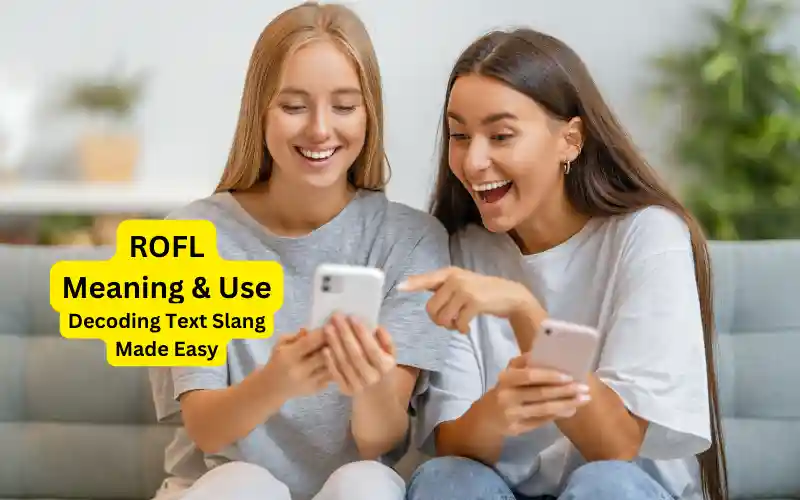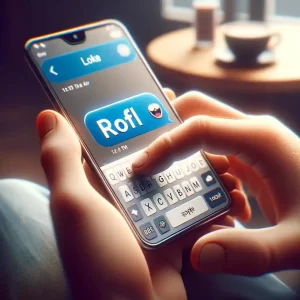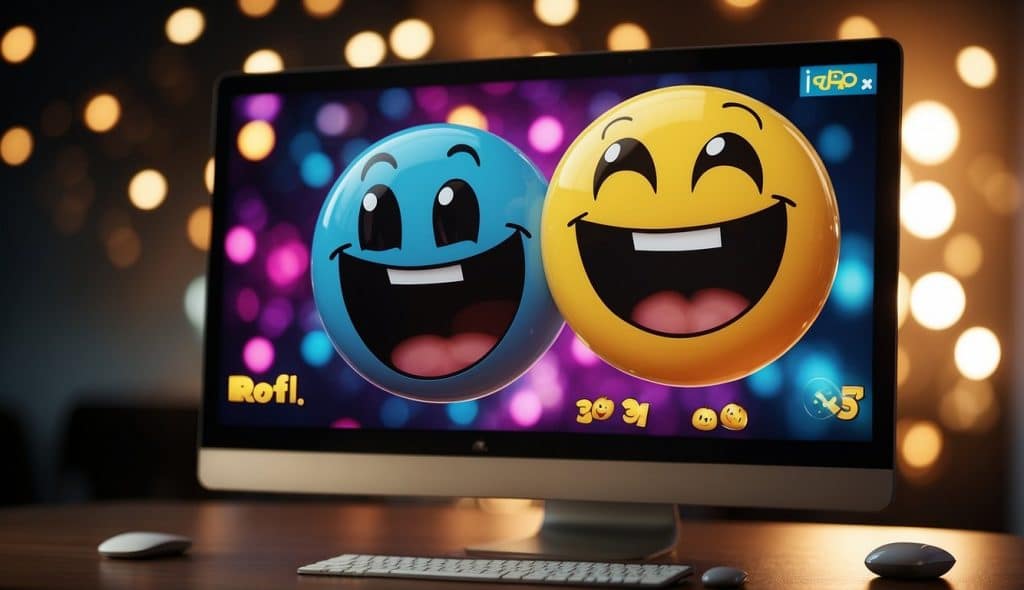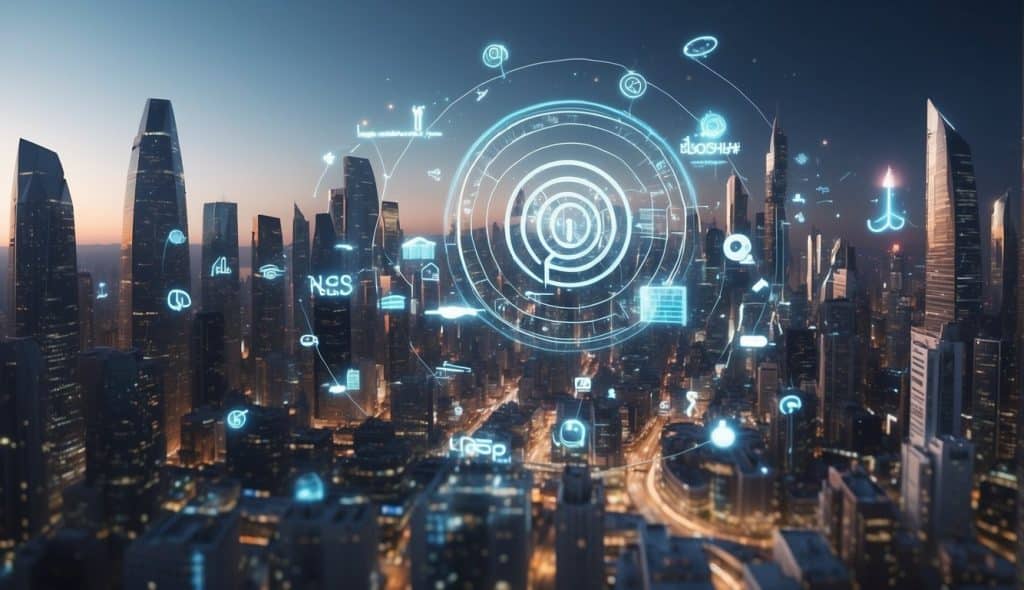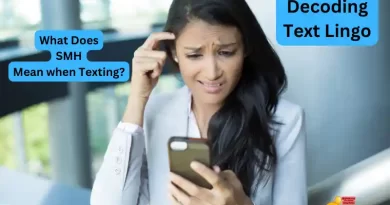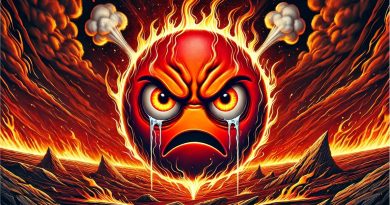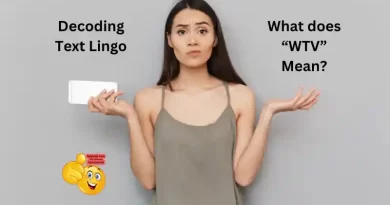ROFL Meaning: Understanding the Classic Internet Acronym
Amid the sea of online slang, ROFL stands out as a flag of intense humor. Its use signals more than just a chuckle; it’s the equivalent of a noisy, breathless belly laugh in the virtual domain. As we text, chat, and communicate across various platforms, understanding the nuances of such internet slang helps keep our conversations lively and accurate to the expression of our emotions. Let’s dive into the vibrant world of ROFL, where a few keystrokes evoke imagery of laughter so powerful it sweeps us off our feet.
Key Takeaways of ROFL Meaning
- ROFL is an acronym that indicates a strong reaction of laughter.
- It reveals a higher level of amusement than similar abbreviations used online.
- Knowing the appropriate context and usage enriches our digital communication.
Origin of ROFL

When I first bumped into “ROFL” in a chat, I was puzzled, but soon I learned it’s an abbreviation for “rolling on the floor laughing.” It’s like shouting to the world, “That was hilarious!” This term rolls way back to the early days of Internet chatting.
History tells us that we owe a nod to internet relay chat rooms of the past. Think about a time when LOL, or “laughing out loud,” was the cool new phrase. With the advent of more dynamic online expressions, “ROFL” emerged as a way to show even more amusement.
Before “ROFL” became a mainstay in our digital vocabulary, expressions like “rolling in the aisles” were already painting pictures of uncontrollable laughter in our minds. If LOL suggests a giggle, then “ROFL” implies I’m laughing so hard it’s like I can’t even stay in my chair!
The abbreviation found its footing—or should I say, lost its footing?—and morphed from a niche slang into a widely recognized way to react to something incredibly funny. It indicates a stronger reaction than LOL, hence earning its unique placement in the lexicon of internet slang. We might not literally hit the floor every time we use it, but it sure does communicate our entertainment level.
So next time someone sends a joke that sends you into a fit of giggles, go ahead and hit them with a “ROFL.” Trust me, they’ll know they’ve earned a virtual pat on the back for their humor. 😂👌
Comparison to Similar Abbreviations
When it comes to texting and online communication, laughter is often expressed through a variety of abbreviations. I’m going to dive into how ROFL stacks up against its cousins LOL, LMAO, and LMFAO.
ROFL vs LOL
ROFL (rolling on the floor laughing) is used when a chuckle just won’t cut it. While LOL (laugh out loud) indicates laughter, ROFL suggests a more intense reaction. Imagine LOL as a giggle during a funny chat, but ROFL is when I’m so amused I can’t stay in my seat.
ROFL vs LMAO
Next up, LMAO (laughing my ass off) is somewhere between LOL and ROFL. It communicates hearty laughter but without the vivid imagery of literally rolling on the floor. I use LMAO when LOL is too mild, but I’m not quite at ROFL levels of amusement.
ROFL vs LMFAO
Lastly, let’s talk LMFAO (laughing my freaking ass off), which turns up the intensity even more. LMFAO is used for those side-splitting moments when laughter completely takes over. Think of LMFAO as a step up from LMAO, implying an even stronger reaction, rivaling ROFL in its intensity.
What does ROFL Mean in Digital Communication
In the world of instant messaging and social interaction online, certain abbreviations like “ROFL” have become staples. Let’s dive into how it’s used across various platforms, such as text messages, emails, and social media.
Text Messaging
In text messaging, “ROFL” is a go-to initialism to express that something is extremely funny. Here, brevity is key, and since texts are often sent quickly in an informal setting, “ROFL” fits perfectly. For instance, if I’m chatting with friends and someone shares a hilarious joke, I might reply with, “ROFL, that’s too good! 😂” This shows I’m literally laughing out loud.
Emails tend to be a mix of formal and informal communications. However, “ROFL” typically finds its place in casual emails, often between colleagues with a friendly rapport or friends. For example, when sharing a funny article with a co-worker, I might say, “This had me ROFL 🤣, thought you’d enjoy it too!” It keeps the tone light and friendly.
Social Media
On social media, “ROFL” is widely used to convey laughter and amusement. Whether it’s in response to a meme on Facebook, a tweet, or a video on Instagram, “ROFL” underscores the humor in the content. Since audiences on social media are diverse, using “ROFL” appropriately depends on the context and language of the post. Like, if I see a comedian’s sketch that’s spot-on, commenting “ROFL, your timing is impeccable! 👌” is a great way to participate in the communal chuckling.
Exploring the ROFL Meaning within Linguistic Context
First off, let’s chat about where ROFL fits in the grand scheme of English. This term pops out as an abbreviation that stands for Rolling On the Floor Laughing. It’s a colorful way to express that you’re laughing super hard—imagine literally tumbling around on the floor because something’s just that hilarious. 😂
ROFL has its roots in online slang where brevity is king. As I see it, people needed a quick way to show they were more than just “haha” amused, especially in the fast-paced world of digital chatting. 📱 This led to ROFL becoming part of the lingo, especially among younger audiences who jive with internet culture.
When it comes to context, timing and setting are key. ROFL is casual, so it’s at home in texts, memes, or social media—places where it’s all about vibing with friends. But imagine dropping a ROFL in a work email 📧 or in a formal chat. Yikes, right? It’d be like wearing flip-flops to a business meeting. So, I keep ROFL for chill convos where a dash of fun is on the menu.
Still, while the word “ROFL” might sound cozy in English, translations could lose that zesty flavor. Other languages might have their own wild expressions that are just as fun but don’t translate exactly. And let me tell you, language is a fantastic beast that way, constantly evolving and throwing up gems like ROFL. So here’s to words that keep our chats zippy, fresh, and full of good vibes! 🎉
Variations of ROFL
Before diving into the whimsical world of internet acronyms, let’s explore some popular twists on “ROFL,” which stands for “rolling on the floor laughing.” These variations add extra layers of humor and are often used to amplify just how funny something is.
ROFLMAO
“ROFLMAO” takes the hilarity up a notch by combining “ROFL” with “LMAO,” which means “laughing my ass off.” When I use “ROFLMAO,” I’m saying that something is incredibly funny, so much so that it’s got me both rolling on the floor and laughing my butt off.
ROFLCOPTER
Next up, “ROFLCOPTER” is a playful expansion that sees me as not just rolling on the floor laughing but flying around like a helicopter because I just can’t contain my amusement. It’s a fanciful metaphor suggesting that my laughter is so intense it’s propelling me through the air!
LULZ
Lastly, “LULZ” is a term I use for laughs, particularly when talking about humor derived from internet memes or pranks. It has cyberculture roots and sometimes associates with the mischievous side of online humor, often appearing in forums or gaming communities. It’s a variant spelling of “LOLZ,” which is the plural form of “LOL” (laugh out loud).
Expressions of Laughter in Online Communication
When we’re chatting online, I find it fascinating how we use various terms and symbols to express our laughter. It’s like we have our own digital language of amusement!
Written Laughter
Written expressions of laughter are as diverse as they are entertaining. We often see simple repetitions of ‘haha’ to signify amusement. Sometimes, the intensity grows to a ‘hahaha’ or even a robust ‘bwahaha’ when something is particularly funny. For those moments when we are absolutely cackling, ‘rolling in the aisles’ captures a very animated form of laughter. These written forms have evolved into acronyms like ‘ROFL’, which stands for rolling on the floor laughing, highlighting an extreme reaction to something hilarious.
In addition to ‘ROFL’, we have ‘LOL’ for ‘laughing out loud’. Even longer strings, such as ‘ROFLMAO’ (rolling on the floor laughing my a** off), are not uncommon. These acronyms condense our reactions into a few letters, perfect for quick and easy online communication. They have become an integral part of our online interactions, signifying intense amusement with sharp brevity.
Emoticons and Emojis
But wait, there’s more! We have a whole arsenal of emoticons and emojis that serve the same purpose. 😂 – the face with tears of joy emoji – is so widely used it was even named Oxford Dictionaries’ Word of the Year in 2015. A simple ‘haha’ can become a lot more expressive with 😆 or even 😹 when chatting with friends. From the classic sideways smiley ‘:-D’ to the straightforward emoji ‘😂’, we have countless ways to show we’re laughing behind the screen.
These tiny graphic symbols have transformed our digital conversations, allowing for a visual representation of our laughter and amusement. My personal favorite, 😂, instantly conveys my reaction without the need for words. And when I’m going for a more cheeky or sardonic laugh, I might opt for the smirking 😏. It’s incredible how much personality and emotion we can convey with just a few taps on the keyboard.
Combining ROFL with Emojis for Maximum Laughter
One of the best things about digital communication is how we can amplify our emotions with the use of emojis. When it comes to expressing laughter, combining the ROFL acronym with the right emoji can take your message to a whole new level of funny! 😆 Let’s check out some examples:
Classic ROFL + Tears of Joy Emoji 😂
The most iconic pairing is ROFL with the 😂 emoji. This emoji, known as the ‘face with tears of joy,’ perfectly captures the essence of rolling on the floor laughing. So when you type “ROFL 😂,” it’s like saying, “I’m laughing so hard, I’m crying!” It’s perfect for those moments when something is just hilariously out of this world.
ROFL + Rolling on the Floor Emoji 🤣
For a more literal take, pair ROFL with the 🤣 emoji. This ‘rolling on the floor laughing’ emoji is like a visual representation of the acronym itself. Use this combo when you want to show that you find something incredibly funny, almost like you’re physically rolling around in laughter.
ROFL + Skull Emoji 💀
If something is so funny that it’s to die for, then ROFL paired with the 💀 skull or death emoji is your go-to. This pairing suggests that you’re laughing so hard, it’s like you’re ‘dead.’ It’s a cheeky way to express extreme amusement, especially in response to a hilariously dark joke or a situation that’s absurdly funny.
ROFL + Crying Face Emoji 😭
When the laughter is overwhelming, and you want to emphasize the emotional intensity, use ROFL with the 😭 (loudly crying face) emoji. This combo is perfect for those situations where you’re laughing so much it’s almost therapeutic, a release of pent-up emotions through the joy of laughter.
ROFL + Clapping Hands Emoji 👏
Sometimes, the humor is not just funny, it’s also clever or impressive. In these cases, pair ROFL with 👏 (clapping hands) emoji. This indicates that you’re not only laughing hard, but you’re also applauding the wit or cleverness behind the joke.
Incorporating these emojis with ROFL not only adds color and personality to our messages but also helps bridge the emotional gap in our digital communications. It’s a playful and creative way to ensure our messages convey the right level of fun and engagement. So next time you find something uproariously funny, don’t just say ROFL, show it with the perfect emoji! 😂🎉👌
Cultural Impact of Internet Slang
Internet slang like “ROFL” has woven itself deeply into our cultural fabric. I’ve seen it influence humor, communication, and even entertainment. It’s funny how a catchy acronym like this signifies more than just rolling on the floor laughing. It’s a playful symbol of our shared online experience.
Let’s take memes, for instance. These images or videos go viral because they’re catchy and relatable. When they feature slang, it often elevates their appeal. Think about how often you’ve seen “ROFL” in captioned images that ended up spread across platforms quicker than wildfire.
Moreover, when people interact through comments or chats, they use slang to convey complex emotions briefly. It’s fascinating to observe cultural shifts where spoken language now includes terms like “ROFL”. These terms enhance our digital dialogues and make interactions feel more personal, despite physical distances.
Interestingly, internet slang also influences the creation of content. Creators sprinkle slang in their videos or blog entries to appear more relatable. They know that a touch of internet lingo can transform a simple post into something memorable and shareable.
Lastly, because I’m focusing on how approachable and understandable my writing needs to be, I remain aware that using slang requires a delicate balance. It’s all about hitting that sweet spot where the language is still clear but retains its youthful and entertaining essence. Slang breaks barriers, creating a cultural bridge where we all stand on common ground, chuckling, and maybe actually rolling on the floor with laughter. 😄
Semantic Expansion Over Time of the Meaning of ROFL
When I first came across ROFL in an internet relay chat, I chuckled. It stands for “rolling on the floor laughing,” a phrase that brilliantly captures those moments when something is unbelievably funny. Initially, ROFL and its usage were limited, but semantics, much like a living organism, evolves.
In the digital realm, ROFL became more than just an acronym; it symbolized amusement in online interactions. Its usage skyrocketed as social media platforms emerged, each tweet and status update becoming an opportunity for ROFL to shine. But there’s more to it! Understanding how ROFL’s meaning expanded is like watching a plant grow—innumerable branches representing different contexts where the term thrives.
Let’s break it down:
- Internet Relay Chat: ROFL’s birthplace where early adopters set the trend.
- Social Media Platforms: A new stage for ROFL, as platforms like Twitter and Facebook became ubiquitous.
As people embraced internet lingo, ROFL became part of their everyday language, the same way ‘cool’ or ‘awesome’ did. The evolution of semantics isn’t just about dictionaries and academia; it’s about how actively we reinvent words in vibrant online communities.
Enthusiastic use of ROFL has tailored its meaning. Now, it’s not just an expression; it’s a shared understanding among netizens worldwide, a symbol of our digital culture. So, next time you text ROFL, remember, you’re adding to the grand tapestry of its semantic expansion! 🌐😂📱
The ROFL Meaning: Proper Use and Etiquette
When it comes to using ROFL in your messages, think of it like a potent spice – a little goes a long way. This acronym stands for Rolling On the Floor Laughing. As you might guess, it signals that you’re finding something hysterically funny. It’s perfect for those moments in a text or email when a simple “haha” just doesn’t cut it.
Knowing When to Use ROFL
Firstly, it’s great for casual conversations, especially when responding to a joke that’s truly side-splitting. However, remember it’s a no-go for formal emails or messages where professionalism is key. Stick to a light-hearted text message or when chatting online with friends.
Slang Terms and Respect
Also, consider who you’re talking to. Not everyone’s up on their slang terms, and while your friends might appreciate “ROFL,” your grandma might be left scratching her head.
Alternatives to ROFL
There are other abbreviations like TIL for Today I Learned, TTYL for Talk To You Later, or even PMSL which is a bit more risqué. Use them when you feel they fit the vibe of the conversation. And, of course, when it comes to slang, trends can change. Always be on the lookout for new terms but don’t force them into your chats. That’s just awkward, and I’d hate for you to be that person. 😉
So, as a rule of thumb, use “ROFL” when you’re genuinely laughing out loud, and share that laughter with friends who’ll appreciate it. Keep it out of your professional emails, and you’ll be golden. Keep it friendly, keep it fun, and most importantly, keep it real! 🎉
ROFL in Popular Culture
What is the meaning of ROFL? Its a text abbreviation for “rolling on the floor laughing,” has become more than just internet slang—it’s a cultural phenomenon. First off, we’ve seen memes that picture people literally rolling on the floor in laughter, which captures the essence of this expression perfectly. It’s funny because it exaggerates how we react when something’s truly hilarious. Memes serve as the backbone of modern humor, particularly among younger folks like us. They help us share a quick laugh with friends and family, even if we’re oceans apart.
Moreover, ROFL isn’t just stuck in the digital realm. You’ll hear it spoken out loud in conversations, especially when recalling a funny incident or joke. It’s like saying LOL (laughing out loud), but ROFL ups the ante—implying that you’re laughing even harder. Thanks to social media, these acronyms have infiltrated our daily lingo, making them a staple in pop culture references.
Then there’s “ROTFL”—a close cousin of ROFL—which stands for “rolling on the floor laughing.” Both expressions intermingle freely within pop culture texts. They aren’t just expressions; they represent our collective sense of humor and our desire to connect through comedy.
In my world, it’s common to drop a ROFL in a group chat after someone shares a particularly funny meme. It’s our quick, go-to response when words fail to convey how funny we find something. Emojis often follow suit, with the 😂 face being a visual representation of ROFL.
Lastly, comedy shows and sitcoms have caught on too. Catchphrases that resonate with the humor of ROFL occasionally pop up. For example, when a show’s character is in stitches, you can bet the audience at home is being prompted to ROFL right along.
By becoming a verbal and visual shorthand for shared amusement, ROFL symbolizes how humor has evolved in the age of the internet. It’s like we’ve created a universal script for laughter that transcends borders and brings us together, one meme at a time.
The Future of ROFL and Internet Slang
With the rapid pace of technology, I’ve noticed that text messaging and social media are reshaping our language. Like many of my friends, I often use acronyms like ROFL when chatting online. It stands for “rolling on the floor laughing,” pointing to a level of amusement.
Looking ahead, I can see the evolution of internet slang continuing to mirror changes in society and tech. Shorter, quicker forms of communication are likely, especially as more voices from around the globe contribute their unique expressions. As someone who often texts, I think we can expect variations of ROFL to pop up.
Interestingly, internet slang like ROFL seems organic in nature. As new trends emerge, so do new words. I’ve even seen some of my Danish friends use it, which shows the global influence of online language.
But also, in my circle, abbreviations like ROFL are often swapped out for emojis. 😂 These little icons might carry the torch into the future of digital conversation, making it even more visual.
Moreover, as a teen, I find that blending acronym slangs with visual elements like GIFs makes chatting more vibrant and expressive. The future might see a blend of text and multimedia taking over, making ROFL and its contemporaries a nostalgic relic.
Wrapping Up
Diving into the ROFL meaning has been an absolute blast! This journey through the world of internet slang reveals how a simple acronym can encapsulate so much joy and humor. From its roots in online chats to its widespread use across various digital platforms, understanding the ROFL meaning gives us a deeper appreciation for the way language evolves in our hyper-connected world. It’s not just about the letters R-O-F-L; it’s about the shared moments of laughter and the vivid imagery of merriment they conjure up in our digital conversations. As we continue to text, tweet, and message each other, let’s remember the joy that terms like ROFL bring into our lives, transforming our digital language into something truly expressive and fun. Here’s to many more ROFL moments, keeping our online interactions lively, hilarious, and authentically human! 😂👍
As I wrap my mind around this, I imagine language constantly adapting. While traditionalists might wrinkle their noses, those like me on social platforms will likely drive this change. Keep an eye out – the language you see me use today might be different from next year’s trend! 👀
Frequently Asked Questions
When texting ‘ROFL’, it conveys that something is extremely funny. It’s like saying I’m laughing so hard, I could be rolling on the floor.
Online, ‘ROFL’ is like a stronger version of ‘LOL’. It means that I’m laughing out loud, really hard. It often shows up in response to a hilarious meme or joke.
In a dating situation, if I send ‘ROFL’, I mean I find something extremely amusing. It’s a casual way to show I have a good sense of humor.
The acronym ‘ROFL’ in internet chat stands for ‘Rolling On the Floor Laughing’. It’s one way I express that I find something very funny.
‘ROFL’ is mostly for laughs, but sometimes it could be used sarcastically if I’m not actually amused. It’s important to read the room, so to speak.
Just like in English, other languages have their versions of ‘ROFL’. In France, people might use “MDR” (Mort De Rire), which translates to “Dying of Laughter”, while in Germany younger people typically use the English equivalent for the ROFL meaning.

